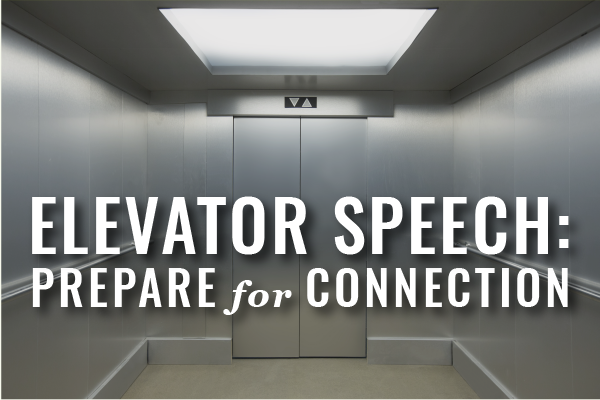If you’re looking at every new connection getting ready to deliver your pitch, you’re doing it wrong. Focus on what matters.
Save your elevator pitch for Startup Alley. You might never need to deliver an actual elevator pitch per se. You’ll always need to introduce your name and the work you do in a variety of settings. But very few situations ask for you to follow your personal introductions immediately with your professional goals and skills.
Take the “Elevator Speech” label off your introductory conversations. Words matter. First, your brain doesn’t need to associate performance anxiety every time you meet someone. Second, if you’re delivering an elevator speech when you’re trying to sell your services, you’re not heading for conversion. And if you’re trying to make a referral or strategic connection, even the best branded elevator speech underperforms dyadic human conversation.
PITCHING, SELLING, OR CONNECTING?
Maybe you really are bringing your work to ABA TECHSHOW’s Startup Alley, trying to convince a panel of judges that your idea should win in strictly limited time. You’ll prepare a pitch for the specific idea you’re putting in the spotlight, and if it’s successful it won’t be about you much at all — it’ll be about your solution. You’ll spend considerable time refining and rehearsing your script, incorporating feedback from practice audiences. Good luck out there!
Pitches that *are* about you are called job interviews, and meetings with prospective clients *are not* job interviews. You tailor how you introduce yourself in job interviews to the job, and you refine and rehearse as you would delivering a product pitch. You can find plenty of books on how to perform well in interviews and plenty of guidance on pitching products — none of which will help you improve individual connections.
When you’ve just met a prospective client, your goal is to sell. To sell your legal services, you need to convert your prospective client by focusing the value they need help creating, protecting, or restoring. Pitching your generic value is rarely enough to convince someone of what it’s worth to them. Sales conversions require specialized communication skills you can learn as a lawyer (start here!) — but it isn’t as simple as opening a canned elevator speech.
Appreciate the opportunity to converse, do not deliver a speech — even a short, fast one. If you aren’t talking to a prospective client, your new connection might fit into your referral network or your strategic growth network. Making a meaningful connection requires more than a scripted opening. Narrowing your focus to an illusory window of opportunity will foreclose real opportunities.
MAKING IMPRESSIONS.
Whether you acknowledge it or not, you have a brand — how others perceive the sum of your impressions. Inconsistent brands are ineffective, weak brands. If you aren’t focused on being intentional with the impressions you make, you might have an inconsistent brand at best — or worse, a brand that doesn’t communicate what you want it to.
The most critical element of your brand is trustworthiness. You can find a deeper dive on how lawyers can communicate for trust here. Our privileges can lead us to think, say, and do offensive things unintentionally. Lawyers need to take active steps to address unconscious biases — practicing mindfulness can help.
The more impressions you make that reinforce your brand, the quicker you’ll come to mind for your new connections. Our brains remember patterns more effectively than we remember individual instances. With a weak brand, your new connections might recognize you when they see you but won’t think of you when asked for a referral in your practice area.
WHO + WHERE.
Whether you have clear goals for your career plans or not, you can’t predict who you’ll meet and can help you — or where you’ll meet them. Seek conversations with valuable connections you’re able to discern in advance but recognize that random connections might have even more value. If you’re introverted, you need to invest effort in planning recovery to create a sustainable socializing habit.
Concentrate on learning about individuals as you talk with them. If listening as an energetic kid was hard, listening as an adult with a bunch of responsibilities and goals is way harder! First, our seasoned brains are trying to think of responses before we even begin conversations. Second, we can process words 5 to 15 times as fast as we speak them. Focusing on conversations requires active practice. Get tips from Celeste Headlee here.
WHAT + WHY.
The substance of your introduction should be the easy part. My colleagues on our clinical team remind us that “should” is an unhelpful word, and I recognize it’s least helpful to tell lawyers they *should* enjoy their work. But if you aren’t passionate about your work, you can do something different. Far more helpful than “should” — you can get our 5-part workbook series on Career Research & Development for Lawyers here (all 105 pages are FREE).
Be prepared to describe your work for two basic frames of reference: Lawyers and Everyone Else. With other lawyers, it can make sense to label yourself as “a divorce lawyer”, but to everyone else you might want to say “I represent clients through divorces.” You’ll also want to tailor how you explain your work environment and target market differently depending on your new connection’s frame of reference. Pay attention to subtle and explicit feedback, and refine your descriptions to make them resonate effectively.
Go big on your purpose or go home. If you aren’t enthusiastic about the work you do, your new connection won’t be either. Talk about the parts of your job you enjoy. Talk about why you continue to choose the work you do; talk about work you want to explore. And at the same time, you can be honest about how difficult parts are.
You want your brand to be reliable. Being a lawyer is hard work and without proper self-care, burnout can take over suddenly. Don’t hesitate to acknowledge that you’re a real human — everyone else already knows — and they’ll want to trust that you “fill your cup” if they’re going to trust you to pour more from it. When talking about how you practice self-care, beware the trend of companies sling self-care for their own profit, and focus on making time to do what you enjoy — or making time to discover something you enjoy!
HOW.
Do you need to practice your speech in front of a mirror? TRICK QUESTION — IT ISN’T A SPEECH, REMEMBER? Speaking in front of a mirror will help you speak better, yes. If you do work that’s hard to explain, mirror time might help — but more likely real world practice, attuned to feedback, will help better.
“Power Pose” your body to feel confident and comfortable. And remember to speak and breathe from low within your abdomen. Shallow breathing will make you (and your new connection!) tense. Don’t underestimate the power of mind-body connection.
Listen for an opportunity to do a 5-minute favor for your new connection as you consider common interests. Whether you’re in a personal or professional setting when you meet someone, you’ll ultimately decide whether to invest any further time in your new connection. Finding an opportunity to send them information — whether related to work or personal interests — gives you a better format to follow up than scheduling another chat over coffee.
Be flexible when you exchange information for later followup. The standard business card swap is fine if you really want to send email and schedule coffee, or are just looking to end the conversation. But with a normal networking volume, following up on each business card can take more time than you’re ready to commit.
If you don’t want to make immediate plans, open your LinkedIn app while you’re together and connect. Social networking technology makes it much easier to stay in touch until you reach a point where you can help each other. You can exchange cards at your kid’s soccer game, but you can also connect by phone or on Instagram first, and LinkedIn later. You want an organized system for time management, but tech makes it easier to systemize customization.
Finally, get comfortable with discomfort if you aren’t already. When two humans meet for the first time, communication might be awkward, particularly around ending the conversation. Looking for solutions to make it feel better is wasting your time — you need to practice navigating conversations to improve. Our clinicians can help if you’re experiencing overwhelming fear — find more on scheduling here. But you won’t find much else can spare you the overwhelming experience of human connection.
Sure, pretend to get a phone call or need to use the bathroom suddenly. Or just glance around the room, smile, and extend your hand as you say, “It was great talking with you.” They’ll get it. And if they don’t, they don’t, and you focus on your next connections.
. . .
Two previous posts on our blog now redirect to this post (“Funnel Vision: Elevating Your Elevator Speech” and “Love in an Elevator: Convey Your Zeal, Competence and Confidence in Sixty Seconds or Less”).




